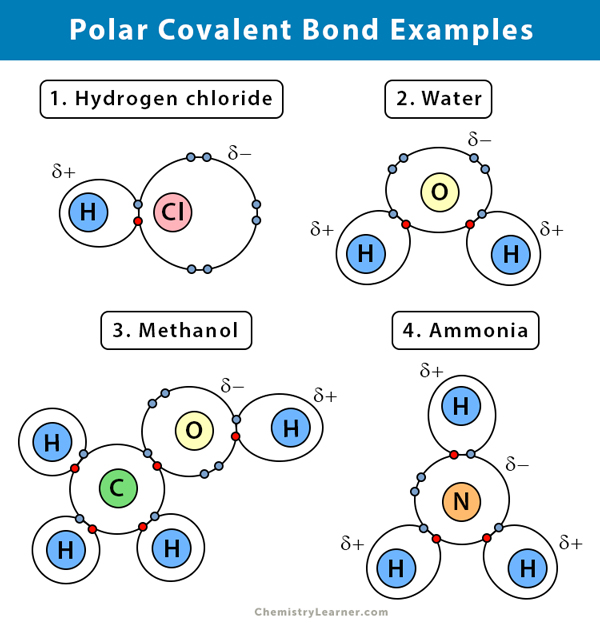Describe Polar Covalent Bonds Using Water as an Example
Examples of Covalent Bond. A polar bond is a covalent bond in which there is a separation of charge between one end and the other in other words in which one end is slightly positive and the other slightly negative.
Polar Covalent Bond Definition And Examples
Different ways of representing the polar sharing of electrons in a water molecule.

. The pair of electrons involved in this type of bonding is known as a shared pair or bonding pair. This is an example of a polar covalent bond which is created because of the higher electronegativity of oxygen. In general a polar bond is a certain class of a covalent bond.
The water H 2 O is the most classic example of a polar molecule. A water molecule abbreviated as H2O is an example of a polar covalent bond. The oxygen atom carries a partial negative charge since electrons spend more time with it.
The CO bond is a double covalent bond while the C-N bonds are single covalent bonds. The most common example of a polar covalent bond is H2O or water which is made up of two hydrogen molecules and one oxygen molecule. However in a covalent bond the atoms are bound to share electrons.
A water molecule abbreviated as H2O is an example of a polar covalent bond. Polar Covalent Bond Examples of Molecules with Polar Covalent Bond. In WaterH 2 O molecule two hydrogen atoms share their single electrons with the oxygen atom which shares its own two electrons in return.
The electrons are unequally shared with the oxygen atom spending more time with electrons than the hydrogen atoms. In the covalent bond between oxygen and hydrogen the oxygen atom. An ionic bond is a type of chemical bond in which the atoms have different electronegativity values from each other.
See answer 1 Best Answer. Covalent Bond Definition Types Properties Examples. The electrons are unequally shared with the oxygen atom spending more time with electrons than the hydrogen atoms.
Chapter 5 Lesson 1. Water abbreviated as mathbf H2O is an example of a polar covalent bond. Polar bonds are the dividing line between pure covalent bonding and pure ionic bondingPure covalent bonds nonpolar covalent bonds share electron pairs equally between atoms.
In this bond the oxygen atom has a stronger pull so it gets the larger share of the electrons giving it a partial negative charge. Examples of polar covalent bonds. Examples include most covalent bonds.
Water consists of a covalent bond containing hydrogen and oxygen bonding together to make H 2 O. We can also say that it is the dividing line between the formation of a pure covalent bond and an ionic bond. For example sodium Na and chlorine Cl form an ionic bond to make NaCl table salt.
Electrons are unequally distributed with oxygen atoms spending more time with electrons than hydrogen atoms. The hydrogen-chlorine bond in HCl or the hydrogen-oxygen bonds in water are typical. A covalent bond is formed when electrons from both participating atoms are shared equally.
Hydrogen Molecule H2 is a non-polar covalent bond example as an electron pair. Polar covalent bonds form among atoms with an electronegativity difference between 04 and 17. In water one oxygen molecule forms double polar covalent bonds with two molecules of hydrogen.
The electronegativity amount of oxygen is 344 while the electronegativity of hydrogen is 220. However if we want to define it more accurately a polar covalent bond is a bond that exists between two atoms consisting of electrons that are unevenly distributed. For example if we talk about water H2O it is a polar covalent bond.
Describe polar covalent bonds using water as an example. Water is a Polar Molecule Key Concepts The water molecule as a whole has 10 protons and 10 electrons so it is neutral. The sharing of bonding pairs will ensure that.
In terms of intramolecular bonding there are hydrogen bonds between urea molecules each carbonyl oxygen accepts 4 from N-H hydrogens. Water H2O is a polar bonded molecule. Hydrochloric acid or HCl is formed by a polar covalent bond between one atom of hydrogen and one atom of chlorine while carbon dioxide consists of one atom of carbon joined to two atoms of oxygen.
In a b the polar covalent bonds are shown as lines. In part c the polar covalent bonds are shown as electron dots shared by the oxygen and hydrogen atoms. Since electrons spend more time with the oxygen atom it carries a partial negative chargeAnother example of a polar covalent bond is between a.
An example is water. In this atomic molecule two hydrogen atoms share their single electrons with the oxygen atom which shares its own two electrons in return. Technically nonpolar bonding only occurs when the atoms are identical to each other eg H 2 gas but chemists consider any bond between atoms with a difference in.
Molecular bonds are another name for covalent bonds. In a water molecule the oxygen atom and hydrogen atoms share electrons in covalent bonds but the sharing is not equal. It is said that water is the universal solvent but this does not mean that it dissolves universally but rather that due to its abundance it is a suitable solvent to dissolve polar substances Helmenstine 2017.
Each diagram shows the unsymmetrical shape of the water molecule. For water the. A covalent bond is a bond where atoms share electrons.
Properties Of Water Covalent Bonding Polar Covalent Bond Unequal Sharing Of Electrons A Great Example Of A Molecule With Polar Covalent Bonds Is Water Ppt Download

0 Response to "Describe Polar Covalent Bonds Using Water as an Example"
Post a Comment